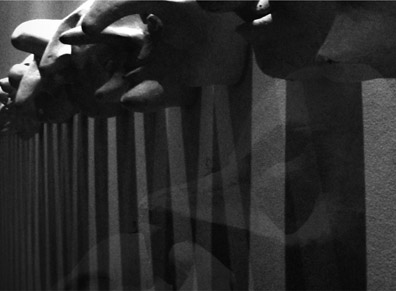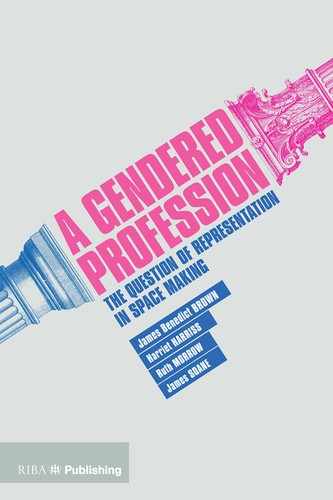All the world’s a stage,
And all the men and women merely players;
They have their exits and their entrances,
And one man in his time plays many parts,
His acts being seven ages.
William Shakespeare
As You Like It
Act II, Scene VII, Lines 139–1661
To practise architecture is to negotiate relationships of space and time, both through the design and the practice of space. With the stage carefully set, as a young architect I ready myself to make my entrance to the profession; to play out my roles, to respond to the right cues, to present the prepared lines. But to play my part also requires a critical, personal navigation of the fluctuating terrains of relations with others and with myself through space and time; a navigation which implicates, among other things, gender and age.
The particular circumstances of the overlaid relationships between people, space, time, and ideas construct the profession of architecture as a socialised space. Each reiteration of these established relationships encourages considering the profession in certain terms, embedding assumptions about its boundaries, membership, and practices. Increasingly aware of what is excluded by these terms, architects engage with methods for eroding norms, for clambering over the walls of the profession. This opening up to broader subjectivities includes renegotiating the significance that things other to architecture might have from a practical or theoretical perspective. But such considerations are often limited to differences with visual status, such as gender and ethnicity. We stop short of extending the rubric to include other participating forces, such as time and place.
One way of responding to this gap is to relocate these hidden variables. In this chapter, I consider age as a means of bringing time to the surface. Age is a personal topography on which relationships with self and others overlay with professional roles and outputs. Age is illuminated by the cross-pollination of gender and time, calling the temporal aspects of practice, knowledge and daily life to the fore. My intention is not to survey the current status of age within the profession, but to place some markers for discussion; to highlight themes both within wider practices and as evidenced by my personal positions. In doing do, I am able to explore the positioning of architects not only to space, ideas and others, but also to the passages of time relevant to architectural production. I ask: how does age configure our relationship to practice, or impact our professional identities? What might understanding age as a constructed spatio-temporal identity reveal? And can we harness age as a potentially transformative agent for practice?
Constructing Professional Identity through Age
My Practice and My Age
Positioning Myself
Age is personal, held close to our current and past identities. Our relationships to and productions of architecture through time are ways of unfolding our own autobiographies. As a young female architecture graduate, age provides the dominant lens for my current reading and positioning of myself relative to the profession. I locate myself as practising within the profession, as an educator and mentor of students alongside it, and as a writer reflecting on it. Occupying these various positions modifies my understanding of age. Perhaps it is curious that I grew up and now practise in the relatively young country of New Zealand, which maintains a post-colonial preoccupation with the distinctions between people and places of different times. Associated with power, success and respect, and often conflated with size, age seems to play a particular role in the collective narratives of this nation. To engage with my own age requires an awareness of these positions and orientations to the profession, an understanding of how I practise time with respect to each.

Writing Age
The act of writing about age redevelops a particular patterning of knowledge for me. Time seems to be paused, enabling me to draw out a constellation of relations between my work and my changing, ageing self. To write time is to create a place for age, to capture a momentary positioning of my own age within the broader practices of the profession, aligning with what Jane Rendell identifies as critical spatial practice.2
Thinking on Gender and Age
Identities of class, sexuality, disability, ethnicity and age operate alongside gender. The same disciplinary constructions framing the image we hold of an architect’s gender and race also infer their age. Collectively, these assumptions anticipate, complicate and extend the privileges, inequalities and methodologies within and around the profession. Post-structural feminists, including French thinkers Luce Irigary and Hélène Cixous and American Judith Butler, have taken up the task of identifying and exposing these systematic biases and associated identity politics in particular, enabling us to rethink practice and space as gendered.3
Gender and Age
The rewriting of gender as a spatial derivation proposes that if gender is a way of practising space, it is also a way of constructing and understanding it. Through this spatial function, gender operates as a translator, shifting the profession towards new types of knowledge and anticipating new practices. As both age and gender contribute to politics of identity, their roles overlap. Age also translates, carrying us from one understanding towards others, projecting us forwards, and allowing us to reflect back.
By extension, feminist interpretive techniques might assist in following the trajectories of age, providing a starting point for a rhetoric of age. Often the voices of feminism smooth the lines of identity. But gendered space is worked over by the traces of time, understood through the lens of age and the ageing of others. The outdated male/female gender binary is extended by the age binary of young/old – albeit a false binary, existing only momentarily. Following a continuous trajectory of difference through time, age might offer tactics for destabilising other more pervasive binaries.
To understand this interwoven nature, I frame age as an adjacency to gender. I will unravel ways in which the operations of gender and age trace similar paths and suggest how they might cross-inform one another in the production of new and alternative practices.
Age in Practice
Age structures the profession. In practice, offers of employment, acceptance of work, and invitations to contribute are often based on experience that comes with age or, conversely, on the capacity for growth conferred by youth. Age operates as a selective two-way lens for understanding and knowledge.
Limiting our understanding of age to biological definitions ignores the complexities of age as a social and historical construct. Ageing is way of framing similarity and difference. Yet, age is a casualty of discussions that privilege differences between individuals over differences within individuals over time. Framing age as other, the profession of architecture seeks to repress difference. But age and gender echo one another, curious and inescapable. Age is simultaneously a product of gendered practice, a contributor to the gendering of practice, and a gendered practice in and of itself.
Women and Age in Practice
The role of age in practice is particularly evident in the trajectories of women in architecture. Globally, despite near gender equivalence in architectural education, there is a significant reduction in the number of women in established roles in professional practice.4 Is this discrepancy an indication that women are more vulnerable to the changes of time? Or that as women age, their gender, and its incompatibility with some aspects of practice, becomes more pronounced? Either way, the indication is that age is critically bound to the perceived value of individuals and their ability to participate in our profession.
Age as Practice: Three ways of Growing
I want now to put forward three particular ways of practising age: growing into, growing out of and growing through. Each provides a different reading of the navigation though time and the complexities of architectural production. Although mapped separately, in practice they are interwoven. Rooted by the word growing, these sections offer temporal positions, orientations or relations indicating the instability of age, which constantly changes. Growing refers to life, stages, seasons or periods of time, as in ‘growing up’ or ‘growing old’. In some ways, growing is an affront to a profession that has traditionally sought stasis, and which often privileges expert knowledge over learning. Prepositions locate age as a mechanism that traverses between two points. Through each, I plant the questions: is age an orientation also? How might we project ourselves forward, or back? And what is the use of age?
I Growing Into

The phrase ‘You’ll grow into it’ assumes a present day ill fit – a bit too long here, overly baggy there; a lack of confidence in the wearer. To have to wait to grow into it can be disparaging, or an estimation of fine planning: time will pass; have patience, and do all you can with what you have at the given time. Here, I examine my current fit, setting the scene for how age is implicated in day-to-day practices and relationships.
Experiences of Age
Each day, I am a different age. Yet, with differences barely perceptible except over years, we struggle to perceive age as changing. We enact it unknowingly, as a silent component of our lived identity. For this reason, we typically participate in relationships with others as if age is fixed. In a professional environment, stepping into relationships and roles on this basis distinguishes personal age-identity from external, aesthetic readings of the body. The work of critical feminist thinkers picks up on the attention that age draws to the body, revealing the embodiment of architectural knowledge, aligning architectural practices with corporeal processes.5
Youth, revealed by bodies and faces, is burdened by assumed lack of knowledge, requiring young professionals to grow into architecture. Age is positioned as a determining factor of capacity, perhaps in part due to the misalignment of university education with professional practice. Competency, gained through breadth of experience, and repetition of tasks occurring over time, attracts value. Where youth is ‘lost’, age is ‘gained’: a tool to be wielded. Such presumptions around age are normalised in day-to-day practice and are rarely raised as part of a critical discourse.
Growing into it suggests that there is a perfect age for contribution, underlining an assumed correct way of doing architecture, which feminist architectural thinkers have rallied against. Buildings are produced slowly, so ageing folds in with architecture. To be seen as an architect is to have completed a building, an accomplishment which requires time. In this construction, the grandeur of a completed building often overshadows the coming of age of the architect.
The Right to Architect
In her book Coming to Writing, Hélène Cixous suggests that a woman writer must establish her right to write.6 To establish their right to practise, architects might attempt to increase or decrease their perceived age through superficial means: clothing, language, performed self-importance. They ignore the ways in which their age identity mediates their values and practices, potentially adding value to their design contributions. Age shifts from a mode of representation to a negative identity and tool of oppression. This negation of age echoes the practice of women acting like men in order to succeed according to the profession’s existing model of success, rather than challenging the model on their terms. But age is in constant negotiation. To assume age is to take up a position, to locate an entry point or a transition, to state your own terms of welcome.
II. Growing Out of

What does it mean to grow out of? To no longer fit, to expand beyond, to move outside accepted limits or comforts. An important aspect of feminist architectural practice has been the testing and relocation of professional boundaries, through which existing models are questioned, providing groundwork for redefined practices.
Examples of such feminist practices include Fluid, muf, Public Works, and the architectural collective Matrix, all of whom position their practices and operations at the fringes and thresholds of the profession, working in a loosely architectural manner and often collaborating with artists and publics. Operating between macro and micro scales, their methods not only move beyond traditional modes of practice but also critique methodologies that emphasise object making over collaboration and process. They develop participatory and dialogical approaches to understandings of site. Architecture is reclaimed as the location of process, rather than discrete outcomes.
A number of practices established by architects of a certain age operate on similar principles. For example, Assemble, a creative collective of young architectural graduates who in 2015 won the Turner Prize for Art, the United Kingdom’s most prestigious prize in contemporary art. Rather than following an assumed professional trajectory, their decision to grow out of the profession refuses the assumed role of age. Their awarded project was a refurbishment of houses in Granby, South Liverpool, in an area of old buildings left to decay. Their response confronts age head on, intervening in the inevitability of time to regenerate a sense of place. As a non-professionally accredited entity, their work had limited recognition within the architectural realm until the art community awarded it. Both Assemble’s forays into art and their mode of practice as a collective sit outside the anticipated architectural trajectory.
In the practices of muf and Assemble, age and gender are called upon as spatio-temporal methodologies, enabling alternative spatial practices. This questions ways of working learned as part of the processes of coming of age, destabilising the norms reproduced by older, embedded professionals. Those engaged in practices of growing out of are not what Luce Irigary would call speaking subjects in the existing symbolic order.7 Rather, young architects occupy positions at the edge, poised for entry, exit, or some other action. The formation of a collective voice is a strategy for overcoming age. They identify as a new generation of critique through practice.
III. Growing Through

To grow through is to occupy, but also to traverse; to meet obstacles and opportunities with awareness and motion. Growing through reveals ageing as a process of reproducing self in different roles through, and in relation to, the profession of architecture.
Interrelations between my location, identity and knowledge of the profession have been experienced through and modified by age. Each project undertaken unfolds through a sequence of constructions, questions and changes. Design becomes a performative act of engaging self within the project, a bridge between memory, identity and place. Age does not precede contribution, nor does growth follow learning. Rather, age is complicit in the production of what Donna Haraway has called situated knowledge, which, located in or through time, grows, shifts and fades.8 If we consider age as a spatio-temporal identity, we can then perform age, occupying different positions, negotiating between present and future selves.
The profession is the stage for these performances, with a cast of constantly changing individuals, each informed by and informing practice. As members grow through practice, the profession is transformed, and relationships between individuals are continually renegotiated. New stages are established, new roles allocated. Understanding the ageing process relative to the profession in this way opens up alternative forms of hybridity latent within practice, revealing the richness of opportunity of growing through, rather than into, up or out of.
A Drawing Together
These discussions of age through a feminist framework coalesce to identify age as a critical spatial practice. Age is an everyday activity, but is also a constructed lens through which the profession is understood and engaged with. Processes of ageing, then, are methods of continual re-attendance to, and reinvention of, both the self and the discipline. The processes of growing into, growing out of, and growing through that I have discussed broaden our understanding of age beyond the Shakespearean linear, biological seven stages. They suggest that age has the capacity to alter practices, contributing models for reframing and resisting existing dominant modes of practice.
Given the uncertain but unrelenting sequence of ageing, to provide a conclusion as a kind of full stop seems counter-productive. Instead, I wish to offer up some further questions, touchstones for possible future trajectories of age. Why is age a barrier to interaction with the profession, and have the ages of acceptance changed over the generations? How can we open up the profession to the opportunities latent within the variety of ages and ageing processes? In doing so, can we reposition the role of time in architectural production? And finally, how might we each understand our own personal age as a trigger for critical engagement with our own practices and professional positions?
